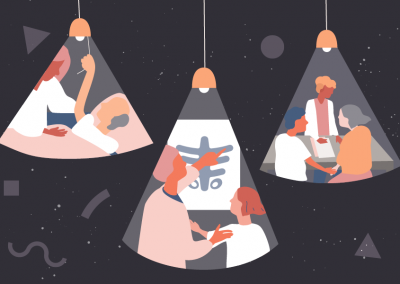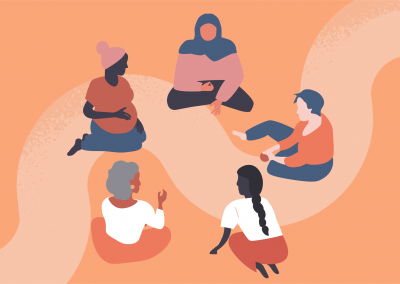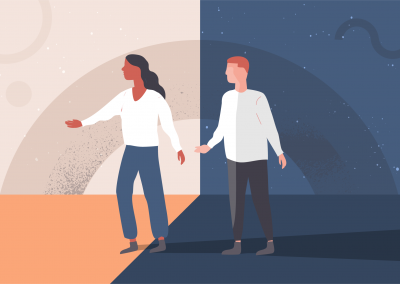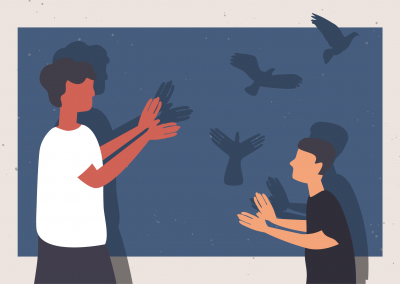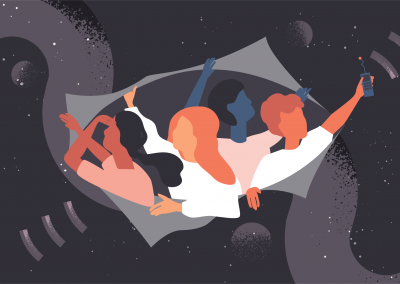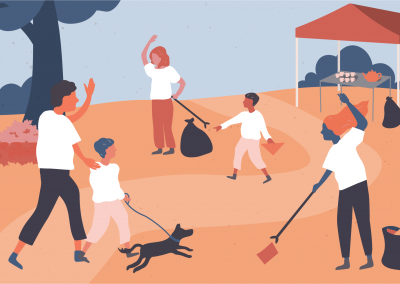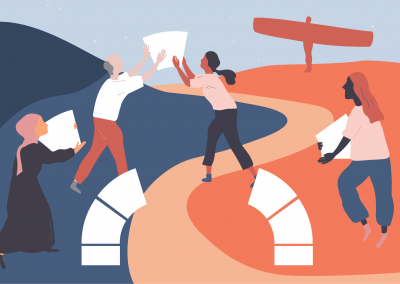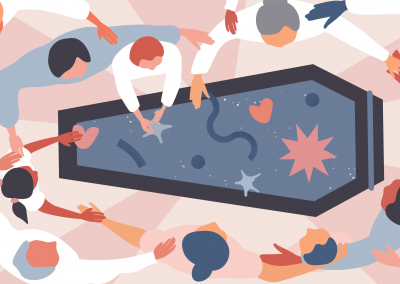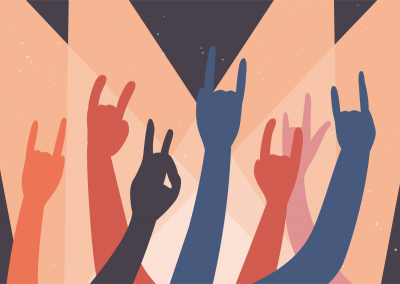MAIA
Connecting artists and communities to spark radical imagination
In 1974, scientists sent an interstellar radio message: one of humankind’s first attempts to make contact with other lifeforms. The message contains information about humans, the solar system, DNA, the elements, and could theoretically be picked up by any beings who intercept it. As long as they have a radio.
In 2023, MAIA, a Black and women-led organisation in Birmingham, made a recording at a community event and sent their own message to the stars. Their broadcast will travel through space for millions of years, transmitting information about radical imagination, the transformative power of art, and life in the West Midlands to remote corners of our galaxy and beyond.
We were struggling to sustain a creative career anywhere that wasn’t London. So we set up MAIA to address that and build a community of artists and nurture relationships. We wanted to do something positive together: to try and transform things, interrogate things. You can’t have that collective energy unless there are relationships to begin with
MAIA grew out of relationships between artists in Birmingham and, says Amahra, ‘a shared commitment to mobilise that collective energy into collective action’. A decade later it sent a message from its local community into outer space. What happened?
Making space
Space is a big deal for MAIA – and not just the starry kind. Acknowledging the politics of space is key to MAIA’s mission to resource a movement of cultural workers engaging in radical imagination.
‘In 2015’, says Amahra, ‘we turned our attention to the physical spaces needed to sustain the lives, practices, connections and cultures abundant in our community, and to the question of who has access to spaces to imagine and build, and on what basis.’
Dream work takes a kind of spaciousness that needs attention and resourcing, and so many in our community are navigating multiple layers of crisis in the day-to-day. Displacement, poverty, housing insecurity, climate breakdown – they stem from a set of interconnected, violently extractive relationships and they affect our capacity to imagine. We’re addressing this crisis of relationship collectively and coming together to build spaces rooted in generative relationships and affirming life as the starting point instead
Bit by bit, MAIA developed from a peer-support arts project to an organisation engaging culture as a strategy for justice and transformation. In 2020, they set up their first prototype space, which they call YARD: a townhouse in Ladywood, where they create resources and programmes that channel the power of the arts and Black imagination, and into which they invite their local community.
Culture as strategy
Art, for MAIA, is one of the most powerful vehicles for forging relationships and unlocking imagination.
‘Even now, art is seen as an extra to fluff up a thing,’ Amber says. ‘Whereas at MAIA, we look at culture as strategy. Art can be something that can create transformation.’
MAIA exists to transform systems and structures in the here and now. It does that through resourcing and mobilising artists and their local community to come together and engage in radical collective imagining. Their message to space was masterminded by the artist Daniel Oduntan, as part of a recent programme of events called ‘(Returning to) Black Frequencies’. Before the broadcast, attendees were asked:
If we had the opportunity to put something out into the universe, what advice or guidance would we give to our future kin?
And what are we taking from our ancestors to try and organise now?’
A prompt that deep, and a target as broad as the universe, can spark big ideas. But what was the point of it all? Does the universe really need their advice?
In part, the broadcast was a tribute to Black creators who made their own TV and radio and broadcast it to their communities on pirate frequencies. And in part, it was an audacious, playful and mind-expanding catalyst for collective imagining.
The act of thinking big, and creating something outlandish, is a powerful way to build trusting, meaningful relationships and expand the sense of what it’s possible to do and achieve together. More than that, Amahra says, it develops ‘the personal, structural and sustained capacities needed for transformation, influenced by the methodology of Healing Justice London’.
Bricks and mortar
Having a self-sustaining, community-owned space is hugely important for MAIA’s work, giving them independence from the funding decisions of the state or corporate bodies. YARD gives them a base for ‘building up community and enabling people to connect with and support one another,’ says Laura Holmes, their Finance and HR Lead.
Infrastructure and physical space are intrinsic to MAIA’s artistic and relational practice.
It’s amazing being in a room when an artist is talking to an elder in the community, or when there are young people coming in and they’re having a conversation with a local organisation. There’s a huge need for that communal space to be together and organise together and practise ways of being together.
Physical spaces become organic enablers of relationships.
The MAIA team is currently creating ABUELOS, ‘a relational infrastructure in the form of a hotel,’ explains Amahra, ‘that demonstrates what happens if we embed care and radical hospitality in every layer, from its programme and operations, to its architecture and economic model, to its financing and governance.’ Over the last 7 years, MAIA have been slowly designing it with their local community and the wider ecosystem around them.
‘We’ll never just make a beautiful thing and ask people to parachute into it,’ Amber says. ‘Everything we are building and designing is informed by our community. We don’t have all the answers and we don’t want to operate in an extractive way. It’s really integral that the people who are going to be part of this are part of the design process, part of the governance, part of the exploration that we’re doing.’
There’s something about having spaces where people can be together where there is no price tag attached to it. You don’t have to pay for coffee, you don’t have to buy a ticket. Think about what more becomes possible when artists are gathered together and there are opportunities for people to meet and connect.
‘Bricks and mortar are a bed for possibilities,’ says Amber. ‘There’s work that we do as MAIA but the aim is that the people who come and are part of this then grow their own seeds of possibility.’
Art school
MAIA runs regular Art School events, hosted by artists and open to the community. There is a different prompt each time and different suggested outlets for expression.
In a recent Art School, themed around carnival, the prompt was:
How would we harness our collective energy to transform the streets of Birmingham?
What would we say?
What would we do?
Attendees were invited to respond through a ceremony, a chant or a manual. One group collaborated to create a song with a sound engineer. Another made a 3D block party, incorporating the things they want to see on their streets. Amber made a ‘manual of how we would harness our collective energy to take over the streets in a way that isn’t temporary.’ In these sessions, Amber says, ‘the conversation about what we’re making is almost more important than what is made. That’s where the collective imagination happens.’
Laura was struck by ‘the depth of sharing’ at these events. People go off to make a thing in response to a prompt and then come back to talk about it,’ she says. ‘Some people may never have met anybody there before, but the vulnerability, the willingness to share, the depth that conversations get to is remarkable. There’s something about the way that MAIA set and hold those spaces that brings out all these common experiences that you wouldn’t get from a general chit chat.’
The organising starts here
‘We’ve got an expansive idea of what an artist is,’ says Amber. ‘All of our events are invitations for people to come in and test out the artist in them. The spaces we create might seem far out and utopian, but once we do that imagining we then bring it down to what we can do right now – and that is where the power is in my eyes.’
Outlandish collective imagining can lead to fresher, bolder action in the here and now – and the relationships to underpin that action.
When we’ve been in that process together, what we remember is that actually all we need is ourselves. It’s not something over there; the organising starts right here in this community, right now. We can’t fix the world, but once we have our community and we’re in that same mindset, even the small changes are where transformation happens.
Start with relationships
MAIA’s work is deliberately open and emergent and relationality is central to this. ‘That’s what emergent working has to be,’ Laura says. ‘You start with the relationships and build from that.’
At a recent residency, ‘Accounting and the Black Imagination’, the artist Janet Douglas used string to create a vast web symbolising all the new relationships and pathways that emerge through MAIA’s work: the snowball effect of one interaction leading to another and another, of alternative possibilities unfolding.
Reflection questions
Digging deeper
- What is the significance of physical spaces in this story?
- How do you feel about the role of arts and creativity in relational work?
Applying the learning
- How might relationships enable bold collective imagining in your context?
- What new possibilities might playful, creative practices open up in your relationships?
- How do you think about the connection between relationships and physical space in your context?
More stories
The Relationships Map
The Relationships Map is a space for anyone who believes in the importance of relationships to find one another, share ideas and resources, feel part of something bigger, and realise more than the sum of our parts.

